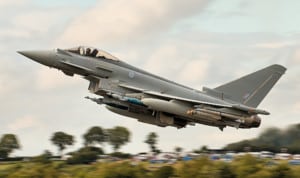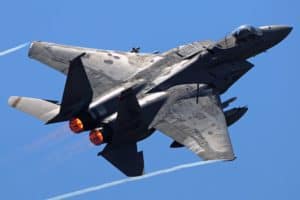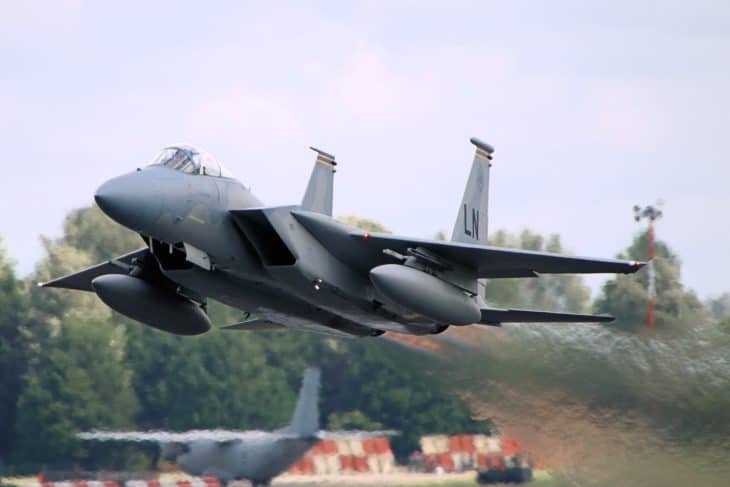The U.S Air Force has been investing to modernize the F-15 Eagle, a fighter that was first introduced in 1976. This should make the F-15 relevant until 2040. Europe on the other hand has been upgrading the legendary Eurofighter Typhoon in order to ensure the fighter remains viable for decades to come. The question in most people’s mind therefore is how do these two stack up against each other?
| Aircraft: | Eurofighter Typhoon T1 | McDonnell Douglas F-15 Eagle |
|---|---|---|
| Photo: |
 |
 |
| Country: | Germany | United States |
| Manufactured: | from: 2003 to: Present | from: 1972 to: Present |
| ICAO: | - | F15 |
| Price: | $90 million | $29.9 million |
| Avionics: | BAE Systems Tranche 2 avionics | F15 HUD, APG-63 and 70 pulse-Doppler radar |
| Engine: | 2x Eurojet EJ200 afterburning turbofan | 2x Pratt & Whitney F100-PW-220 |
| Engine Type: | Turbofan | Turbofan |
| Power: | 13,500 pound-force | 23,770 pound-force |
| Max Cruise Speed: |
1147 knots 2,124 Km/h |
1630 knots 3,019 Km/h |
| Approach Speed (Vref): | - | 250 knots |
| Travel Range: |
2,047 Nautical Miles
3,791 Kilometers |
3,000 Nautical Miles
5,556 Kilometers |
| Fuel Economy: | - | - |
| Service Ceiling: | 65,000 feet | 65,000 feet |
| Rate of Climb: |
62600 feet / minute 318.01metre / second |
50000 feet / minute 254.00metre / second |
| Take Off Distance: |
91 metre 298.55 feet |
275 metre 902.22 feet |
| Landing Distance: |
213 metre 698.81 feet |
1100 metre 3,608.88 feet |
| Max Take Off Weight: |
23,500 Kg 51,808 lbs |
30,844 Kg 67,999 lbs |
| Max Landing Weight: | - |
20,185 Kg 44,500 lbs |
| Max Payload: |
6,486 Kg 14,299 lbs |
10,659 Kg 23,499 lbs |
| Fuel Tank Capacity: |
1,642 gallon 6,216 litre |
4,345 gallon 16,448 litre |
| Baggage Volume: | - | - |
| Seats - Economy: | 2 seats | 1 seats |
| Seats - Business Class: | - | - |
| Seats - First Class: | - | - |
| Cabin Height: | - | - |
| Cabin Width: | - | - |
| Cabin Length: | - | - |
| Exterior Length: |
4.71 metre 15.45 feet |
19.43 metre 63.75 feet |
| Tail Height: | - | 5.64 metre - 18.50 feet |
| Fuselage Diameter: | - | - |
| Wing Span / Rotor Diameter: |
5.28 metre 17.32 feet |
13.06 metre 42.85 feet |
| Wing Tips: | No Winglets | No Winglets |
| More Info: | Eurofighter Typhoon T1 | McDonnell Douglas F-15 Eagle |
|
Data presented is for entertainment purposes and should not be used operationally.
|
Other Eurofighter Typhoon T1 comparisons:
- Eurofighter Typhoon vs Sukhoi Su-57 Felon
- Eurofighter Typhoon vs Sukhoi Su-35
- Eurofighter Typhoon vs MiG 29
- Eurofighter Typhoon vs Saab Gripen
- Eurofighter Typhoon vs Dassault Rafale
- Eurofighter Typhoon vs F-16 Fighting Falcon
- Eurofighter Typhoon vs F-22 Raptor
- Eurofighter Typhoon vs Lockheed Martin F-35 Lightning II
- Eurofighter Typhoon vs Boeing F/A-18 Super Hornet
Other McDonnell Douglas F-15 Eagle comparisons:
We have more variants of each aircraft in our database. On the compare aircraft page you can compare any two aircraft yourself.
The Eurofighter Typhoon

The Eurofighter Typhoon is a close air fighter that also happens to have surface-attack capabilities. One of the things that are synonymous with the Eurofighter is that it has supercruise capability and can reach incredible speeds without using the afterburner.
The fighter aircraft was developed by Munich-based Eurofighter GmbH and is owned by UK’s BAE Systems, EADS Deutschland (previously DaimlerChrysler), Italy based Alenia Aeronautica and Spain’s EADS (previously known as CASA).
During the development phase, Norway had indicated its intention of participating in the development but was non-committal on the purchase of the fighter aircraft.
The McDonnell Douglas F-15 Eagle

The McDonnell Douglas F-15 Eagle is a long range fighter aircraft that is mostly used by the U.S Air Force, The U.S Air National Guard, The Israel Air Force, Japanese Air Force and Saudi Arabia.
It is estimated that there are approximately 1, 500 F-15s in operation. The first F15 made its debut flight in 1986. F-15s are equipped with air-to-air missiles with the ability of being launched from a non-visual range.
The fighter aircraft also has air to ground capabilities making it the perfect fighter aircraft for close-air support. Ordinarily, F-15s are built for stealth. The Boeing F-15 was specifically designed to offer stealth technology cost-effectively. Some of the common features on the F-15 that allow for this stealth are advanced avionics, improved aerodynamics and RCS reductions.
Differences Between the Eurofighter Typhoon and the F-15 Eagle
Cockpit
The Eurofighter uses a voice throttle and stick system for the pilot’s control. The voice throttle and stick system features 24 fingertips controls, a weapon control and sensors. The voice input enables the pilot to make sound commands when carrying out data entry procedures and mode selection.
The flight control system comes with an automatic speed recovery system (ALSR). This system enables the pilot to access audio and visual warnings in case of low speed. Where necessary, ALSR can automatically take over the controls in order to return the fighter aircraft to safety.
The F-15’s cockpit is either a single-crew aircraft mostly found in the F-15A/C, or, there is one that can accommodate a crew of two, often found in the F-15B/D/E. When cruising, the pilot can access flight and tactical details via the HUD holographic field of view. Other information that the pilot and the weapons system officer can access at the cockpit include the infrared sensors, weapons status, electronic warfare and possible threats.
Weapons
The Eurofighter has a Mauser BK27mm gun that is mounted internally. The gun features a revolving system that is linked to a closed-ammunition feed system. There are a total of 13 points of carrying weapons in the Eurofighter Typhoon. Among these points of carriage, four are found under each wing while the rest are under the fuselage.
Monitoring of the weapon status, weapon selection and firing is done with the assistance of an Armament Control System (ACS). Depending on what role the Eurofighter is playing, there is an assortment of missiles that the fighter aircraft can carry.
In terms of weapons, the McDonnell Douglas F-15 Eagle can carry weapon payloads of up to 23,000 lb. These can include infrared-guided air-to-air missiles, radar guided air-to-air missiles and medium range radar-guided air-to-air missiles. Most recently, the F-15 are being equipped with GPS-guided GBU-15 glide bombs. The fighter aircraft is also able to carry a AGM-158 joint air to surface stand-off missile.
How is the Eurofighter Typhoon Superior
When you think about it, there are several features of comparison that can establish areas where the Eurofighter Typhoon is superior to the F-15. One of these areas is the war aircraft’s engine. The Eurofighter has two Eurojet EJ200 engines that deliver 90KN in trust during full reheat and 60KN when in dry-power status.
The EJ200 is developed by Eurojet in Munich. Some of the main features of the EJ200 engine are an integrated health monitoring system, digital controls, convergent and divergent exhaust nozzles, single-crystal turbine blades and chord aerofoils. The engine features of Eurofighter allow it to accelerate faster compared to F-15s.
The F-15 features a Pratt & Whitney F100-PW-229 turbofan engine that has digital electronic control. The engine produces 29, 000lb of thrust allowing the pilot to achieve maximum afterburner from idle thrust in just a matter of minutes.
How is the F-15 Eagle Superior
The F-15 has a number of areas where it can be described as being superior depending on the comparison features with Eurofighter. To start with, the F-15 is considered one of the best war aircraft in terms of maneuverability, avionics, weapons and acceleration.
This makes it possible for the F-15 to penetrate enemy territory with ease and decimate enemy aircrafts within a short period of time and subsequently maneuver out of harm’s way. The weaponry system also has advanced features that enable the detection, tracking and attacking of enemy aircrafts.
The weapons system is designed in such a manner that a single pilot can be able to carry out air-to-air combat. With the high engine thrust, it becomes easier to ensure acceleration and maneuverability whether on enemy or friendly territory. The low loading-rate of the F-15 is what ensures this maneuverability.
Conclusion
If you are to evaluate most of the features between the Eurofighter and the F-15, the differences are not immediately evident. However, the Eurofighter appears to have far more superior features compared to the F-15.
Whereas the F-15s can be said to have more advanced technology, the Eurofighter has more superior maneuverability. In terms of fuel economy, the Eurofighter also ensures fuel economy with a significant difference. The weaponry on the Eurofighter is strategically placed to ensure maximum damage to enemy aircraft.
The only downside is that the Eurofighter requires additional personnel to carry out surveillance and identify threats before taking action.
The acceleration rate of the Eurofighter is much faster, and the climb rate of the Eurofighter has been placed at max. 315 m/s – 65k ft/min while that of the F-15 is at max. 254 m/s – 50k ft/min.
With a relatively smaller size, it would also be harder to have the Eurofighter as a target. Both war aircrafts have impressive features compared to other modern warfare aircrafts. From the analysis above however, Eurofighter appears as the superior war aircraft.


